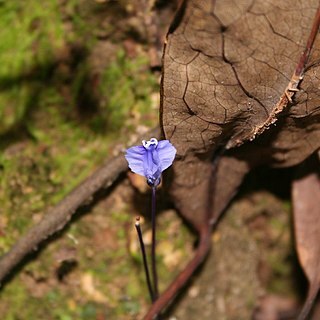Herbs, annual or perennial, mycotrophic and white or purplish, or autotrophic and green. Roots subterranean, mycorrhizal, filiform or stoutly terete. Stems monopodial, unbranched or with few branches, erect, slender; rhizomes present or absent. Leaves present or absent, cauline or basal, alternate, simple, sessile, often scalelike, margins entire; stipules absent. Inflorescences terminal cymes, sometimes appearing racemose or capitate, or flowers solitary; each flower subtended by scalelike floral bract. Flowers: tepals 6, partially or wholly connate, tube persistent or caducous in fruit, limb lobes 3 in 1 whorl or 6 in 2 whorls, greenish, purple, or white, sometimes blue-tinged, often ribbed or winged, throat with or without annulus; stamens 3 or 6, sessile or subsessile; pollen sacs separated on appendaged connective or connective broadened and connate, forming ring proximal to annulus; pistil 1, ovary inferior, 1-or 3-locular; placentation parietal or axile; ovules numerous; style 1, 3-branched apically; stigmas 3. Fruits capsules, ovoid, obconic, or cup-shaped; dehiscence transverse, longitudinal by 3 valves, or irregular. Seeds numerous, minute.
Herbs, annual or perennial, small, mycotrophic, semi-mycotrophic, or autotrophic, often rhizomatous or tuberous. Leaves alternate, simple, entire; autotrophic species with basal rosette leaves; all with cauline leaves. Inflorescences terminal, many-flowered cymes or racemes, or flower solitary. Flowers bisexual. Perianth of 1 or 2 whorls and each whorl of 3 tepals, corolline, tubular or campanulate. Perianth tube often 3-angled or 3-winged; tepals sometimes appendaged; appendages terminal, elongated, slender. Stamens 3 or 6, if 3 then subsessile in perianth throat, if 6 then pendent in perianth tube; connectives large, often appendiculate. Ovary inferior, 1-loculed with parietal placentation or 3-loculed with axile placentation; ovules numerous, anatropous, bitegmic; style filiform, shortly cylindric, or conic; stigmas 3, sometimes connate. Fruit capsular, occasionally fleshy, with either persistent perianth tube and style or only persistent basal ring of perianth, dehiscence irregular or by transverse ventral slits. Seeds small, numerous; endosperm present.
Achlorophyllous, mycoheterotrophic or green photosynthetic (Burmannia) herbs. Rhizome absent (Burmannia) or cylindrical or tuberous and densely covered with scale-like leaves and filiform roots. Leaves alternate or rosulate (Burmannia), sessile, simple, entire, small and scale-like in achlorophyllous species. Inflorescence terminal, cymose or flowers solitary. Flowers actinomorphic, bisexual. Perianth fused, of 1 (not in Australia) or 2 whorls of 3 tepals, campanulate, tubular, infundibular or salverform; tube wingless, 3-or 6-ribbed (not in Australia) or broadly 3-winged; tepals entire or sometimes 3-lobed. Stamens 3, inserted in the tubular part of the perianth, opposite the inner tepals. Ovary inferior, 1–3-locular; placentation parietal or axile; ovules numerous. Fruit a capsule, dehiscent transversely or longitudinally, or indehiscent (not in Australia), crowned with persistent perianth remnants. Seeds numerous, minute, with endosperm.

